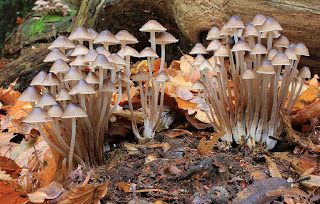by Kim Woolcock
The new year makes me think of new beginnings. Why not new bio-inspired technologies?
As microplastics clog up our newsfeeds and the biosphere, the search for biodegradable materials becomes more important. One that’s catching my attention is fungal fabric.
 |
| Mycena inclinata, Clustered bonnet Image credit: Stu's Images |
When many people think of fungi, they think of mushrooms or mold. Fungi are both of these things, but they are also so much more. The mushrooms that we see popping up in the rainy spring and fall are fruiting bodies, made to distribute spores. They are just the tip of the underground iceberg. Made of tightly intertwined fungal threads called hyphae, they are produced by huge webs of hyphae living invisibly in the soil, in rotting wood, in plant roots and leaves. These hyphae live inside their food, producing enzymes that degrade it, and then soaking up the released nutrients.
 |
| Oyster mushroom (Pleurotus ostreatus) mycelium growing on coffee grounds in a petri dish Image credit: Tobi Kellner |
Hyphae can grow to form any shape (just look at the many shapes of mushrooms, from corals to cup fungi to tooth fungi), and dried mushrooms have a tough and rubbery texture. Innovators are leveraging this combination of traits to produce a wide variety of fungal fabrics. The hyphae are like the threads of cloth, interweaving as they grow. This fabric weaves itself!
Starting with waste products like sawdust or grain husks, designers add fungal spores, a small amount of water, and wait for the fungus to devour the food and fill the mold. Fungi grow quickly, so fungal leather can be produced in a matter of weeks. The resulting mat of hyphae can be dried, tanned, and dyed to produce “leather” that is strong, durable, breathable – and beautiful.
Designers are using fungal leather to make watches, purses, clothing, and shoes. Maybe some fashion-forward fungal leather items are just what my new year needs.
1 comment:
That's so interesting! Thanks.
Post a Comment